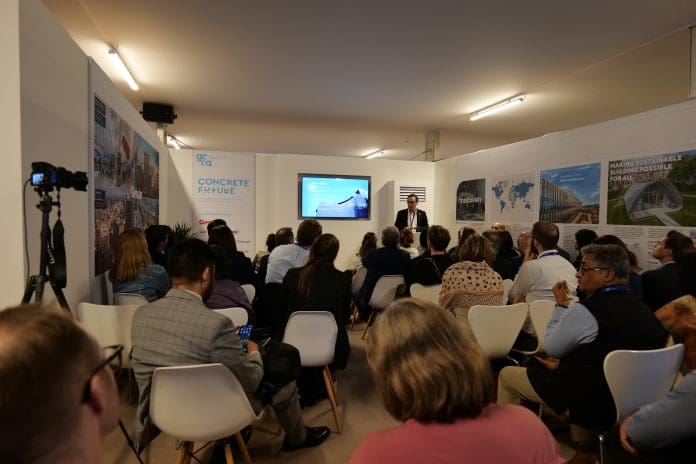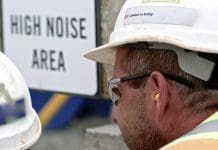The Global Cement & Concrete Association had a front row seat at COP28, hosting a pavilion, Concrete Future, for the first time and highlighting the industry’s work on decarbonisation and sustainable infrastructure. GCCA chief executive Thomas Guillot looks back on the event and the launch of the Cement Industry Net Zero Progress Report
A step forward is how I reflect on the last-minute agreement at COP28. For the first time, countries agreed on the need to “transition away” from fossil fuels.
COP28 was also a big step forward for the GCCA and our own industry. For the first time, we hosted a pavilion, Concrete Future, in the blue zone. That is the official area where government ministers, policymakers, observers and influential stakeholders base themselves and negotiations take place.
Our pavilion became a central focal point, from where we could inform delegates about the work of the GCCA, showcase the decarbonisation action of our members and highlight the essential role that concrete plays in providing the resilient and sustainable infrastructure our world needs.
There is no question the GCCA now sits at the top table for international influencers and decision-makers on industry and net zero.
In all, we hosted 18 successful events in our pavilion during COP28 across a range of topics, including our industry’s work on net zero, policy initiatives, the built environment, CCUS and nature positivity. Our executive team and I also spoke at, and attended, many more events.
It was standing room only at the Concrete Future Pavilion for the launch of our Cement Industry Net Zero Progress Report, our key engagement at the start of COP28.
Attendees came from across the world, including from industry, government and the built environment. The report provides a comprehensive update on the decarbonisation progress our industry has made, two years on from the Concrete Future 2050 Net Zero Roadmap.
You can see a copy of the report here and watch a recording of the launch event at COP28 here.
The GCCA was also proud to have supported the development and launch of the cement and concrete breakthrough at COP28.
Cement and concrete are, of course, essential materials for modern infrastructure and will play a key role in providing the resilient and sustainable housing needed in the future in order to meet the UN SDGs.
Co-led by Canada and the UAE, the breakthrough initiative will help countries share best practices on a range of policies and other measures to help our sector decarbonise.
I was joined at the official launch by Fernando Gonzalez, GCCA president and Cemex CEO; Dr Nicola Kimm, CSO Heidelberg Materials; Raj Narayanan, CMO Ultratech Cement; and Catherine Stewart, Canada’s Ambassador for Climate Change, among others.
We were also pleased to host a Cement Breakthrough Industry Roundtable at COP28, attended by Canada’s minister for innovation, science and industry, Francois-Philippe Champagne; Abdulla Sami Alshamsi, assistant undersecretary, industrial development and national content sector, United Arab Emirates; Andrew Noseworthy, assistant deputy minister for innovation science and economic development in Canada, as well as GCCA member companies.
Fernando Gonzalez and I also took part in roundtable discussions at COP28 at the launch of the Industrial Transition Accelerator, on behalf of the cement sector.
Like the GCCA’s own Net Zero Accelerators, the ITAs are aimed at speeding up decarbonisation of global heavy industries and delivering on Paris-aligned targets by bringing industry leaders together with policymakers, investors and technical experts to help unlock finance and deliver on decarbonisation projects.
The Built Environment
The GCCA Concrete Future Pavilion also played host to several events focused on the built environment, including an event called the Business Case for Sustainability in the Built Environment, jointly hosted with leading built environment design firm, and pavilion sponsor, Gensler.
The co-CEO of Gensler, Diane Hoskins, told the audience that the company is a net zero partner with the cement and concrete industry and “highly dependent on each other”.
“The world will not achieve its climate reduction goals if the emissions from the construction sector are not reduced,” she said, “and as the largest architecture firm in the world, we’re part of this conversation with the concrete industry.”
Hoskins was also joined by GCCA president Fernando Gonzalez, as well as Marta Guzzafame, partner, BCG and Brett Ogilvie, executive leader – sustainability and a board director of Tonkin and Taylor Group.
Innovation and collaboration are leading decarbonisation in the cement and concrete industry
Another session, hosted by the GCCA’s Dr Andrew Minson at the Concrete Future Pavilion, was titled Building Sustainability Assessment Methods, Critical Ingredient to Decarbonise Built Environment.
Shabnam Bassi, deputy CEO at the GRIHA Council, which provides the rating system for green buildings in India, spoke about the importance of sustainability interventions to assess and reduce the real-time impact of construction projects.
Liz Beardsley senior policy counsel of US Green Building Council presented version 5 of internationally used LEED tool.
Our panel of speakers, including Duncan Baker-Brown, chair of the Climate Expert Advisory Group at RIBA, and Emily Grandstaff-Rice, president of the American Institute of Architects, discussed what fundamental choices are shaping how these tools are being developed and refined, how they might take into account climate adaptation and resilience, and how they might be more effective.
Also, at COP28, we launched the third programme in our GCCA Innovandi brand – the Entrepreneur Network. The network brings together start-ups that are developing technologies relevant to decarbonisation across the cement and concrete value chain and enables them to network with GCCA members.
It will be open to start-ups from around the world who are specialising in accelerating the decarbonisation of the cement and concrete industry.
Membership will provide a platform to access the Innovandi mentorship programme and network with peers and GCCA members, as well as access first-hand information on the Innovandi Open Challenge programme.
I also attended the invite only event at COP28, which launched the Carbon Management Challenge, which aims to accelerate deployment of Carbon Capture Utilisation and Storage (CCUS) and Carbon dioxide removal (CDR) projects. The GCCA welcomes this initiative, which should support our industry in developing this essential technology.
I want to express our thanks to all our pavilion sponsors for helping to make our pavilion such a success at COP28: Gensler, ACI and NEU, CEMEX, Heidelberg Materials, Holcim, CEM CCUS and the International CCS
Knowledge Centre.
Our industry’s work to decarbonise concrete and cement continues in 2024.
Thomas Guillot
Chief executive
The Global Cement & Concrete Association
Tel: +44 (0)20 3580 4268

















